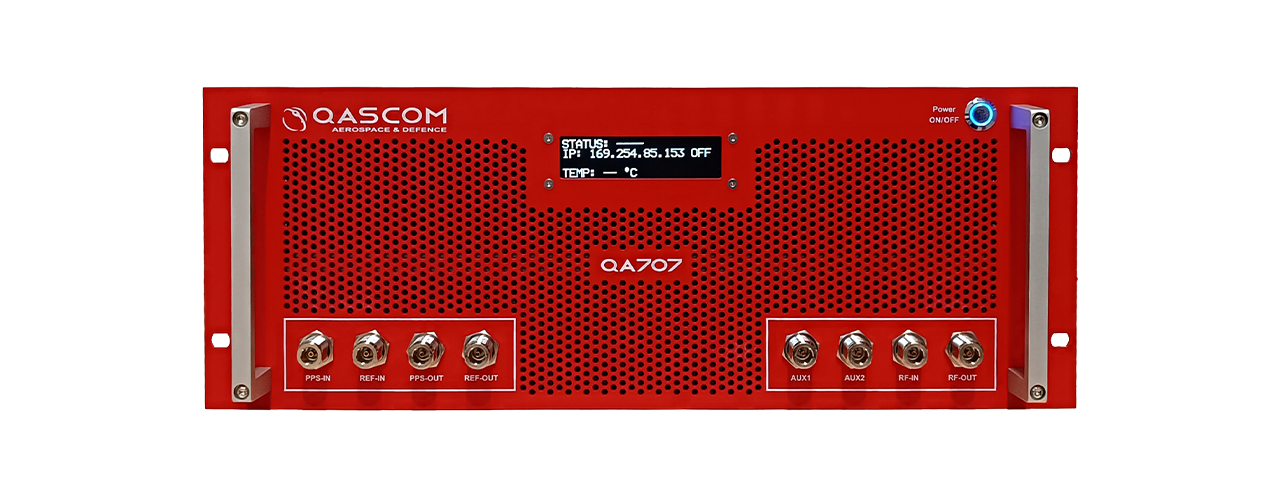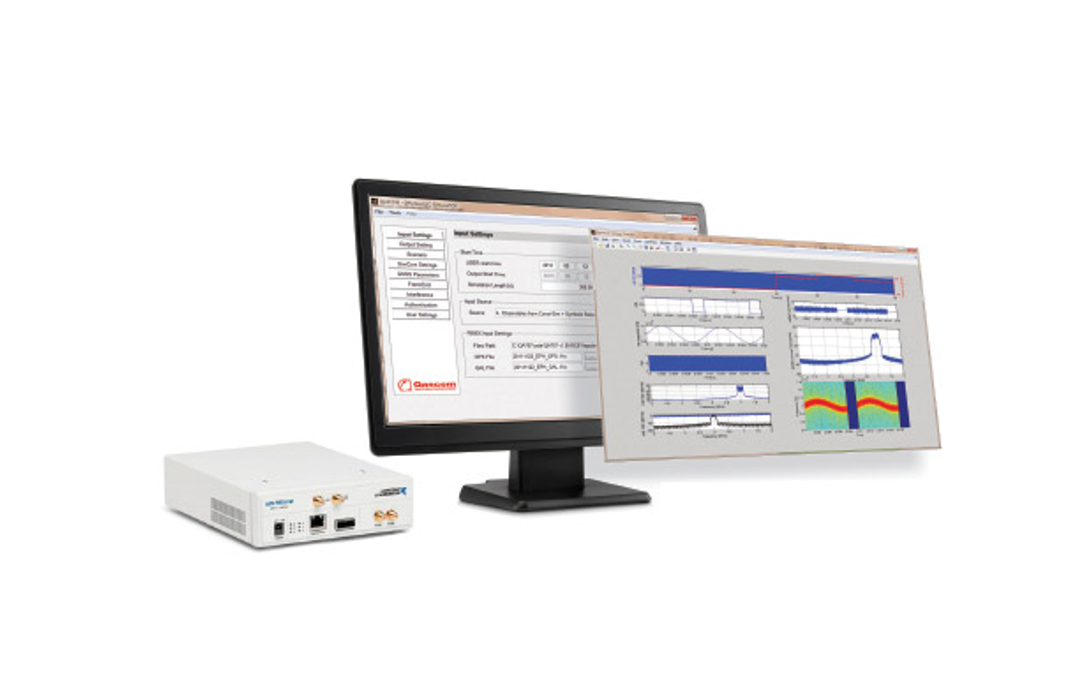Simulators
QA707
GNSS Simulator
Qascom offers QA707, a cutting-edge solution for global GNSS threat awareness and management. The simulator is specifically designed to test both authentication and cyber-attacks, including GNSS interference simulation, deception jamming, spoofing, and advanced cyber-threat management such as data and code-level attacks.
Qascom offers two versions of the GNSS simulator:
- The Hardware Edition (Rack).
- The Software Edition.
QA707 GNSS Simulator

QA707 Hardware (Rack 4U)
The QA707 Hardware Edition is the rack version that includes both the QA707 Software and the radio components, providing a complete solution in a single hardware unit. It is easier to operate, rugged, easily transportable, and the ideal option for defense, industry, and government.

QA707 Software Only
The Software Edition is the QA707 Software and requires a personal computer and an external radio component to operate, such as the National Instruments USRP. This option is more flexible, economical, can use different radios for various experiments, and allows system integrators to build customized solutions for their customers. It is the ideal option for universities, R&D, and system integrators.
QA707 Hardware

QA707 is a Software Defined Radio (SDR) signal generator capable of generating all navigation systems and related cyber-attacks.
The simulator is capable of generating all GNSS authentication signals, including the Galileo OSNMA. QA707 is the ideal product for navigation testing of Earth and space applications, as well as vulnerability testing and security assessments.
Application Areas
- Autonomous driving and vehicle tracking.
- Aeronautics, ADS-B, and high-dynamics applications.
- Launchers testing, including AFTS interface.
- Space GNSS receivers.
- Time retrieval and synchronization.
- Drone navigation testing.
- Railway applications and virtual balise testing.
- Marine navigation and AIS.
- Defense applications, navigation warfare.
Features
- Multi-constellation GNSS (GPS L1 C/A, Galileo E1b/c, GLONASS G1, SBAS L1, GPS L5, Galileo E5a, and more).
- Up to 50 channels in store/reply mode.
- One carrier frequency per simulation (L1/E1, G1, L5/E5a).
- Galileo Open Service Navigation Message Authentication (OSNMA, through integration with QA601).
- Configurable user trajectories.
- Configurable receiver antenna pattern.
- Inner calculation on satellite orbits provided initial orbital parameters by means of Navigation Data RINEX files (one per constellation).
- Emulation of vehicle attitude and inertial sensor measurements (e.g., acceleration, gyroscope).
- RF simulation, binary file dump, signal replay.
- Support for custom SDR platforms through an open API available to customers.
- Runtime streaming of scenario information over UDP (motion, observation data, inertial sensor measurements, generated signal PSD).
- Built-in editing tools: Navigation Data RINEX editor and vehicle trajectory editor.
Specification
System Type
Simulator
RF Cybersecurity Threats for GNSS
Data level Cyber-attacks.
Accurate spoofing signals control, trajectory spoofing, signal replay attacks.
Narrow-band, wide-band and frequency-modulated jamming.
Integrity threats (on request): evil waveform, erroneous ephemerides, code/carrier divergence, low satellite signal power, excessive range acceleration.
OSNMA Support
The OSNMA simulation is an opportunity to test the new Galileo data protected service against several known vulnerabilities in GNSS applications. The OSNMA simulator is available as a standalone tool, names QA601, allowing the generation of OSNMA data that can be used with either QA707 or third-party simulators.
OSNMA Simulator
QA707 supports the integration of QA601, Qascom’s Galileo Open Service Navigation Message Authentication (OSNMA) simulator, provided as a standalone tool that can synergically work with Spirent’s GSS7000 and GSS9000 simulators. OSNMA is a data authentication service available for all Galileo Open Service worldwide users that allows to verify the authenticity of received data, assuring that the navigation message is coming from the authentic system and is not falsified. QA601 supports the latest OSNMA ICD published by EUSPA in December 2022.
QA707 Software

The simulator is capable to generate all GNSS authentication signals including the Galileo OSNMA. QA707 is the ideal product for navigation testing of earth and space applications, as well as vulnerability testing and security assessment.
Application Areas
- Academic experimentations on Navigation.
- Students training and research projects.
- Integration of testbed and navigation testing solutions.
- Drone navigation and R&D testing.
- API integration and experimentations.
Features
- Multi-constellation GNSS (GPS L1 C/A, Galileo E1b/c, GLONASS G1, SBAS L1, GPS L5, GALILEO E5a and more).
- Up to 50 channels in store/reply mode.
- One carrier frequency per simulation (L1/E1,G1, L5/E5a).
- Galileo Open Service Navigation Message Authentication (OSNMA, through integration with QA601).
- Configurable user trajectories.
- Configurable receiver antenna pattern.
- Inner calculation on satellite orbits provided initial orbital parameters by means of Navigation Data Rinex files (One per constellation).
- Emulation of vehicle attitude and inertial sensors measures (e.g., acceleration, gyroscope).
- RF simulation, binary file dump, signal replay.
- Support to custom SDR platforms through an open API available to customers.
- Runtime streaming of scenario information over UDP (motion, observation data, inertial sensor measures, generated signal PSD).
- Built-in editing tools: Navigation Data Rinex editor and vehicle trajectory editor.
Specification
System Type
Simulator
Requirements
QA707 runs on a PC with:
Windows 8 with at least 16 GB RAM.
Windows 10 (preferred) with at least 16 GB RAM.
QA707 Is compatible with several third-party hardware RF upconverters (including National instruments’ USRP) and supports customer-specific hardware through the API interface.
RF Cybersecurity Threats for GNSS
Data level Cyber-attacks.
Accurate spoofing signals control, trajectory spoofing, signal replay attacks.
Narrow-band, wide-band and frequency-modulated jamming
Integrity threats (on request): evil waveform, erroneous ephemerides, code/carrier divergence, low satellite signal power, excessive range acceleration.
OSNMA Support
The OSNMA simulation is an opportunity to test the new Galileo data protected service against several known vulnerabilities in GNSS applications. The OSNMA simulator is available as a standalone tool QA601. Allowing the generation of OSNMA data that can be used with either QA707 or third-party simulators.
OSNMA Simulator
QA707 supports the integration of QA601, Qascom’s Galileo Open Service Navigation Message Authentication (OSNMA) simulator, provided as a standalone tool that can synergically work with Spirent’s GSS7000 and GSS9000 simulators. OSNMA is a data authentication service available for all Galileo Open Service worldwide users that allows to verify the authenticity of received data, assuring that the navigation message is coming from the authentic system and is not falsified. QA601 supports the latest OSNMA ICD published by EUSPA in December 2022.
